In a breeding season and field season that has been a tough one for both the Black Guillemots on Cooper Island and the investigators studying them, today was a day of celebration as morning nest checks revealed that the oldest nestling on the island had departed for the sea during the night. The first fledge...
Category: Black guillemot
Long-term Data Collection Serves Many: Cooper Island study aids graduate students studying climate change
Graduate student Drew Sauve recently returned from Cooper Island. He describes his collaboration with George in this guest post. The Black Guillemots on Cooper Island are one of many wild populations that are responding to climate change by changing when they lay their eggs. These Arctic seabirds want to lay their eggs as soon as...
Hatched! So far, so good for the 2018 chicks on Cooper Island
August 11, 2018: Field report Hatching is finally over with one very late egg hatching today after having been incubated for 34 days; 28 days is normal. The oldest nestling is 16 days old; the chick is gaining weight and doing well like all of the other 45 nestlings. While the main pack ice is...
2018 Census
In this week’s field report, George talks about specific birds as well as the overall report of his 2018 Black Guillemot census on Cooper Island. Nature, when observed or monitored for any extended period, typically provides a predictability that is reassuring in its consistency and sufficient surprises to keep one engaged. For over four decades,...
Seabirds and Sea Ice
Over most of its range the Black Guillemot is a nearshore seabird, occupying coastal waters during both the breeding and nonbreeding seasons, as do other members of the genus Cepphus. Pelagic or open ocean waters can offer abundant prey resources, but these options are often distant, patchy and unpredictable. The nearshore typically offers seabirds a smaller but...
The First Egg!
The first egg of the 2018 breeding season was laid on June 24th by White-Black-Gray. She fledged from Cooper Island in 1995 and has lived through a period of major climate change in the Arctic. Hoping she, and the other 150 guillemots in the colony, have a successful breeding season! The somewhat bad news is...
Cooper Island Video part of NOAA’s “Ocean Today: Every Full Moon” Outreach
The National Oceanic and Atmospheric Administration interviewed George via Skype and put together a concise educational video on the Cooper Island Black Guillemot research and the record warmth of 2016 as part of their Ocean Today Every Full Moon series, a resource for educators. The Cooper Island video is at this link :
Trying to stay optimistic in a seabird colony that is half full – when it is really half empty
The standard and far-too-simplistic “test” of whether someone is an optimist or a pessimist is to ask if they consider half a glass of water to be half full or half empty. The major flaw in the test is that it implies a steady state situation. If the glass is being filled with water, one...
Earliest breeding season in 42 years
The record setting snowmelt in Barrow this spring has resulted in the earliest breeding season for the Black Guillemots on Cooper Island in the 42 years the colony has been studied. Median date of egg laying (when 50 percent of the nests have eggs) was June 16th. Three days earlier than the previous record – set in 2015. Early...
Guillemot Early Breeding Season and New Cooper Island Publications
Fieldwork at the Black Guillemot colony on Cooper Island began in early June, where I began the fifth decade of research on a remote island in a rapidly changing Arctic. Just how rapidly that change is occurring was obvious on the first day in the field, June 11, 2015, when I discovered that egg...
